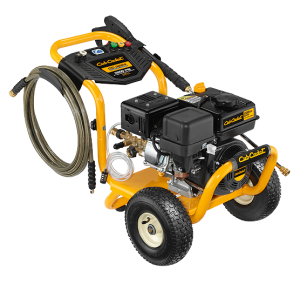 When properly used, a pressure washer can make cleaning anything from sedans to siding almost effortless, but they can also damage surfaces and cause injuries when used incorrectly. This guide will help you safely get the most out of Cub Cadet’s CC3224, CC3425 and CC4033.
When properly used, a pressure washer can make cleaning anything from sedans to siding almost effortless, but they can also damage surfaces and cause injuries when used incorrectly. This guide will help you safely get the most out of Cub Cadet’s CC3224, CC3425 and CC4033.
Stay Safe
The fluid pressures of your pressure washer are high enough to penetrate flesh which can result in amputation and other serious injuries. This includes leaks from loose fitting and damaged hoses.
A backflow protection system is recommended to prevent contamination from water returning from the pump.
What Do the Acronyms Mean?
Cleaning performance is determined by factors other than engine power, so you’ll probably come across these measurements when comparing models.
PSI: Pounds per Square Inch
GPM: Gallons per Minute
CU: Cleaning Units, calculated by multiplying GPM by PSI
Keep in mind that actual performance will vary depending on nozzle head, water temperature and any cleaners used with the washer.
Bypass Mode
When the gun isn’t being used, water inside the pump can be recirculated, controlling internal pressures and eliminating the need to shut off the engine. However, this puts stress on the pump and can cause heat buildup. If the temperature gets too high, a thermal relief valve on the side of the pump will open, releasing pressure in an attempt to lower the pump temperature. If at all possible, avoid leaving the washer running for more than two minutes between uses.
Water Supply
The pressure washer needs a water supply that is at least 20 psi and 5 GPM. Municipal water supplies usually meet these requirements, but some well systems may not have the pressure and flow rate to keep up with the pump. For this reason, Cub Cadet recommends using a supply hose no more than 30 feet (9 meters) in length to reduce fluid friction.
Adjusting Pressure
The pressure setting is set at the factory for optimum pressure and cleaning ability. There are a couple ways to adjust pressure depending on your cleaner model:
Move away from the surface being cleaned – The further the nozzle is from the surface, the lower the water pressure will be when it makes contact.
CC3324 washers: Change to a wider angle nozzle
CC3425 and CC4033 washers: Twist the Dial-N-Wash secondary handle to adjust pressure. The pressure is indicated by a label on the handle: simply twist until the pressure you want is lined up with the arrow on the handle collar.
Nozzles and Uses
Five nozzles are included with the pressure washer, each with a set spraying width: the narrower the angle, the stronger the water stream will be.
Red (0°) – High power pinpoint cleaning for hard, unpainted surfaces. Ideal for unpainted metal and concrete. The stream is strong enough to damage wood surfaces on contact.
Yellow (15°) – High power cleaning for unpainted surfaces including unpainted brick, stucco, concrete and grills
Green (25°) – The standard cleaning nozzle for most surfaces.
White (40°) – A low pressure nozzle for use with painted and other fragile surfaces including automobiles, painted brick and vinyl
Black – This is a low pressure nozzle for use with cleaning solutions.
Applying Chemicals and Cleaning Solvents
The detergent injection system can mix cleaners and solvents into the water stream for better cleaning performance. Only use fluids designed for use with pressure washers; use bleach or other corrosives will damage the washer.
To use the injection system, attach the siphon hose to the fitting between the high pressure hose connection and the pump. Place the other end of the hose in the cleaner/solvent container. Fit the black nozzle on the end of the cleaning wand; other nozzles will not draw from the siphon hose. On CC3425 and CC4033 models, the Dial-N-Wash needs to be set to “MAX” to draw cleaning fluid.
The pump will mix water and cleaner at a 7:1 ratio. In other words, it will use one gallon of cleaner for every 7 gallons of water.
Starting
Before starting, make sure the filter screen is installed correctly in the pump inlet with the screen should be facing outward. Connect the water source to the pump inlet, the high pressure hose to the pump outlet, the gun to the high pressure hose and finally the nozzle to the end of the wand. Turn the water source on and hold down the gun trigger to remove any air inside the pump.
Refer to the included engine manual for instructions on starting the engine.
Shutting Down
If chemicals or detergent were used with the washer, place the siphon hose in a bucket of clean water. With the black nozzle fitted to the wand, spray until any sign of suds have disappeared from the water.
Turn the engine off, then turn off the water source. Pull the trigger on the gun to relieve any remaining pressure. The hoses and gun can now be safely disconnected from the rest of the power washer.
Where to buy Cub Cadet Pressure Washer parts
cubparts.com carries everything for Cub Cadet pressure washers from replacement hoses to engine oil, and they can ship to any address in the U.S. Not sure what you’re looking for? They have an advanced search engine with complete parts diagrams to help you identify the parts you need.
